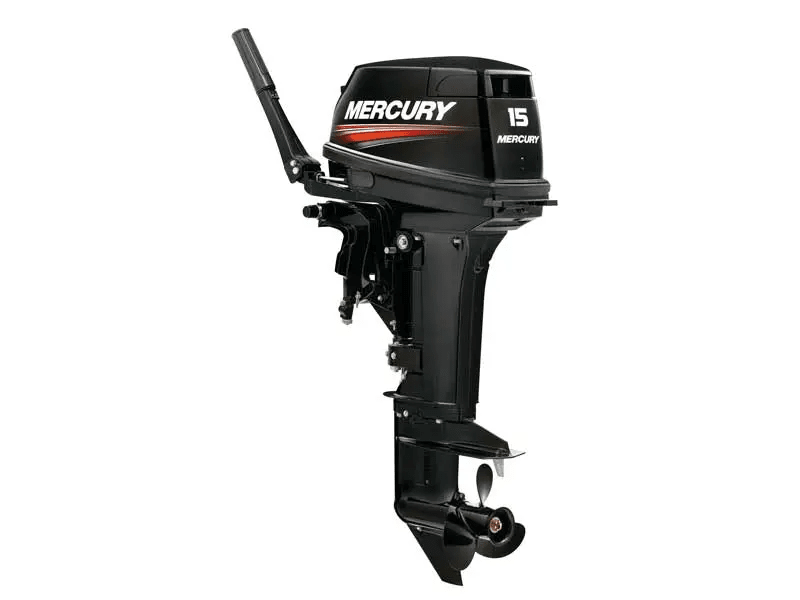
Mercury Super 15 HP Portable Outboard Motor Review
As my twilight years approach, time goes faster. It's hard to believe I first reviewed the Mercury Super 15 in 2000. Since then, the Japanese-made Mercury 15hp Super has been a mainstay of Mercury’s portable outboard range.
The reasons why it’s been so popular are simple – it’s very well-priced, has a long warranty and tons of grunt, and is reasonably economical. It’s the great all-rounder for tinnies to 3.8 metres. And there are plenty of propeller sizes to choose from.
The Mercury Super 15 has the largest piston displacement of any two-stroke 15hp portable outboard engine. In markets outside Australia it’s also sold as an 18hp engine, so developing 15hp it’s safely under-stressed. The side-mounted gearshift is archaic compared to the upfront shifts of its closest Japanese competitor but there are features here not found in that engine.
For example, there’s an auxiliary water cooling intake directly beneath the anti-ventilation plate, so should the main intakes just above the gearcase torpedo become blocked, some water will always reach the cooling system. Just remember to tape up this auxiliary intake before attaching flushing ears or muffs to the main intakes, or the water pump impeller will suck air instead.
Another feature is the provision of six trim positions compared to four so the engine tilt angle can be matched to most transom rakes. The zinc anode beneath the anti-ventilation plate doubles as a trim tab, so steering torque can be virtually eliminated.
The twistgrip throttle control uses an all-rod linkage to the carbie for reliability, and like all traditional multi-cylinder carbie two-strokes, the ignition timing advance is mechanical. There’s even a traditional choke that most of us old farts know how to use. None of that fancy cold-start fuel primer stuff.
Maintaining the Mercury 15 Super is easy. The bowl-type fuel filter, sparkplugs and ignition advance linkages are easily reached. Mercury recommends servicing the engine every 100 running hours or annually after the first 20 hours. The recommended oil is Quicksilver Premium Plus, mixed at 50:1 with either standard or premium unleaded (after running the first 10 hours on 25:1).
The warranty is up to five years, provided it’s serviced by an authorised Mercury dealer—the competition can’t match that!
Putting the 15hp Super to the Test
Over the years, subtle changes have been made to the running quality of the Mercury 15hp Super. The first engine I reviewed was rough as guts below 2000rpm, which gave my arm flab a real massage. But the most recent model smoothed out above 1000rpm, though I still wouldn’t recommend extended trolling unless you want to get the blood flowing in your tiller arm.
Despite the engines running at 25:1, smoke appeared only below 2000 rpm. They started easily with a firm two-hand pull when cold and, with their effective thermostats quickly reached normal operating temperature. When hot, only one hand was needed to fire them up.
Providing the anti-ventilation plates were kept immersed when using shallow water drive power astern was good – handy for backing off shoals. At all times, the pilot water discharges were clearly visible. The engines had good acceleration, and through tight turns at 4000rpm, there was no prop ventilation.
The first hull was a Bermuda 375 Dolphin tinnie, unusually built with a long-shaft transom. This is not a bad idea considering the engine weight, though when it comes to trading in the engine, the resale value may be less than that of a short-shaft model, as most tinnies under 3.8 metres have short transoms. On this hull and pushing a total of 320kg, including two adults and fishing tackle, the review Mercury 15hp Super had the best performance of all the engines tested and frankly, was a perfect match.
The most recent hull was a Kiwi-built SmartWave 3500 polyethylene dinghy, which, though rated to 25hp, still went well with only 15hp. Performance wasn’t quite as good as the Dolphin's, but the engine was pushing a total of 350kg. The main drawback of this hull was the short-shaft transom, which allowed water to flood aboard whenever I quickly closed the throttle, giving me a wet bum every time.
These engines were tested before I acquired my portable decibel meter, but I do remember they became fairly raucous above 4000 rpm.
The Verdict
With the thunderclouds of a sales ban looming over carbie two-strokes in Oz, I’d act sooner than later if considering buying a new engine. Sure, the Super 15 is basic compared to some of its direct Japanese competition, but it’s an honest motor that, with a little TLC, will last a lifetime.
Thanks to Lifestyle Marine, Toronto, NSW and Tomos Marine, Marks Point, NSW for supplying the demo engines.
Mercury Super 15 HP Specs
PRICE: $2100 RRP (short shaft)
TYPE: Loopcharged twin cylinder premix two-stroke portable outboard motor
RATED BHP/MHP*: 14.7/15.0 at 5125rpm
REC. RPM RANGE: 4750 to 5500
DISPLACEMENT: 294cc
BORE X STROKE: 60mm x 52mm
GEAR RATIO: 1.85:1
WEIGHT: 41/42kg dry
OEDA STARS: 1
Ready to Set Sail?
Find your dream boat online at Only Boats! We have great deals on boats for sale including used boats and new boats. You can also check out our used boat buying guide.
If you're upgrading or planning to sell your boat, why not explore our expert guide on improving boat resale value? If you're planning to attend a boat show soon, we've also put together a detailed boat show buying guide that's perfect for first-time buyers.
Smooth sailing starts with the right boat. We’re here to help you find it!
This article was written by Andrew Norton and previously appeared at TradeaBoat.com.au, now powered by Only Boats.
Getting boat finance sorted shouldn't be the hard part of boat ownership. Credit One has helped thousands of Australians get on the water, earning a reputation as Australia's best-reviewed finance broker with 3,000+ glowing Google reviews to show for it. See what customers have experienced by reading their Credit One reviews, or use the loan repayment calculator to work through your options.
